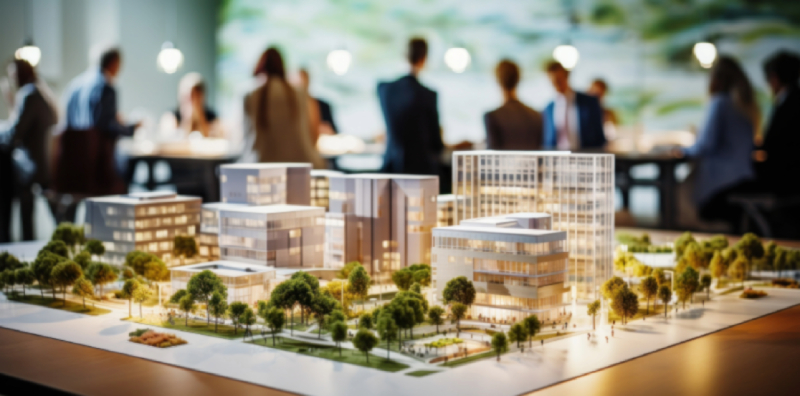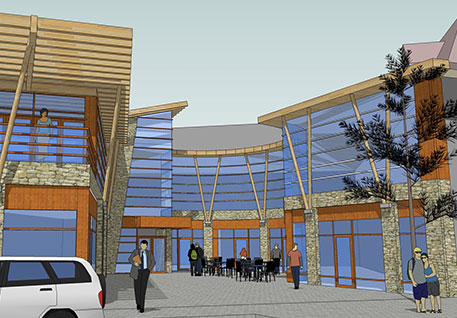Exactly How Commercial Architects Can Transform Your Service Room With Expert Layout Services
Commercial architects play a crucial function in improving organization environments. Their expertise in design can significantly boost both capability and visual appeals. By developing spaces that mirror a brand name's identity, they enhance functional performance and staff member fulfillment. Nonetheless, the influence of their job expands beyond simple look. Comprehending the nuances of partnership and sustainability can cause transformative results. What details aspects make these transformations effective?
Comprehending the Role of Commercial Architects
Commercial architects play an important function in shaping service settings that are both useful and cosmetically pleasing. They concentrate on creating spaces customized to the specific needs of businesses, ensuring that every square foot is utilized successfully. These professionals incorporate components such as spatial format, lighting, and products to boost efficiency and staff member health. By working together with customers, commercial architects gather understandings right into functional requirements and brand name identification, converting these into cutting-edge designs.Additionally, they navigate complex building regulations and zoning laws, guaranteeing conformity while making best use of layout potential. Their knowledge reaches sustainability techniques, promoting energy performance and ecologically friendly products in their tasks. Via their innovative vision and technical understanding, commercial architects not only develop enticing spaces but additionally foster environments that advertise partnership and development. Eventually, their payments significantly influence the total success and picture of a company.
Advantages of Specialist Design Providers

Tailoring Areas to Your Brand Identification
Customizing rooms to a brand's identification is important for sharing its core worths and objective. Commercial architects play a crucial duty in improving a service's visual identification via thoughtful style options. By lining up architectural aspects with brand name concepts, companies can create settings that reverberate with clients and workers alike.
Reflecting Brand Worths
Exactly how can a well-designed space personify a company's core values? Commercial architects play a critical function in forming environments that resonate with a brand's identification. By integrating components such as color pattern, materials, and formats, they produce rooms that reflect the significance of the company. A technology company could choose for open designs and modern furnishings to communicate technology and collaboration, while a deluxe brand name might choose sophisticated surfaces and intimate areas to evoke exclusivity and sophistication. Thoughtful style not only boosts capability yet additionally promotes a solid connection in between staff members, clients, and the brand. Inevitably, a well-crafted setting serves as a concrete depiction of a company's goal and vision, reinforcing its worths at every touchpoint.
Enhancing Aesthetic Identity
What components can properly boost a brand's aesthetic identity within a commercial area? Commercial architects play an essential function in integrating style attributes that reverberate with a business's ethos. Color systems, typography, and products can be strategically picked to reflect brand name values while guaranteeing aesthetic charm. In addition, integrating logo designs and brand name images right into the design can create a natural visual narrative. Illumination style can additionally enhance the atmosphere, directing customer understandings and experiences (commercial architects). Format and furnishings choices must straighten with the brand name's character, whether it's modern-day, conventional, or innovative. Inevitably, a properly designed industrial area not just attracts customers but additionally strengthens brand acknowledgment, creating an enduring perception that cultivates commitment and engagement
Enhancing Functionality and Effectiveness
Enhancing functionality and effectiveness in industrial areas involves maximizing space application and creating process that streamline procedures. Architects concentrate on producing layouts that reduce lost space while facilitating smooth adjustments in between jobs. This technique not only enhances performance however likewise adds to a more cohesive functioning environment.
Optimizing Room Use
Effective room usage is a crucial element in industrial design, where the style should stabilize aesthetic appeals with performance (commercial architects). Architects employ numerous strategies to maximize readily available square video while making certain that each location offers a distinctive objective. By evaluating workflow, traffic patterns, and customer demands, architects can develop formats that improve both staff member productivity and client experience. Multi-functional spaces, adaptable furnishings plans, and maximized storage space remedies are necessary components in accomplishing this objective. Furthermore, including all-natural light and open rooms promotes a much more welcoming environment, further raising the utility of the atmosphere. Ultimately, effective room usage not only boosts functional helpful hints efficiency however likewise contributes positively to the total brand name photo, making it an essential consideration in commercial layout
Structured Process Design
Just how can a well-designed workflow transform a business space right into a hub of productivity? Structured operations design focuses on maximizing the physical layout and functional processes within a business atmosphere. By strategically preparing workstations, meeting locations, and sources, architects can eliminate unnecessary motion and enhance partnership. This thoughtful layout decreases diversions and facilitates interaction, permitting staff members to concentrate on their tasks much more successfully. Furthermore, integrating modern technology right into the operations can further automate processes, minimizing time invested on regular tasks. Consequently, services experience enhanced staff member spirits and raised result, developing a dynamic atmosphere that cultivates advancement. Eventually, spending in structured workflow layout not only improves functionality however likewise positions an industrial area for lasting development and success.
Cultivating Collaboration Through Style
Although contemporary workspaces usually focus on specific productivity, the layout of industrial areas increasingly highlights partnership as a crucial motorist of advancement and team cohesion. Architects play an important role in developing settings that promote communication among staff members. Open designs, multifunctional spaces, and tactically put public areas motivate spontaneous discussions and brainstorming sessions.Incorporating aspects such as movable furniture and adaptable conference room enables groups to reconfigure rooms based on their collective needs. Furthermore, integrating technology, like interactive white boards and video conferencing devices, boosts the capacity to interact efficiently, no matter of location.Natural light and biophilic design components additionally add to a more welcoming environment, advertising convenience and health, which are crucial for effective synergy. By concentrating on these aspects, industrial architects can develop dynamic environments that not only boost cooperation yet additionally drive overall business success.
Sustainable Design Practices in Commercial Design

Case Researches: Successful Transformations by Commercial Architects
The execution of lasting design practices has not just reshaped the method to industrial architecture however has likewise led to exceptional changes in various business spaces. One notable situation is the redesign of a technology firm's headquarters, where architects integrated natural light and green wall surfaces, leading to enhanced employee health and productivity. This change decreased energy expenses by 30% and boosted the firm's public image.In another circumstances, a store undertook a complete overhaul, using redeemed products and energy-efficient systems. This not just attracted eco-conscious consumers however likewise enhanced foot traffic by 25%. A 3rd case entailed a corporate workplace that welcomed an open-plan format with versatile work spaces, promoting partnership amongst groups. The architects' emphasis on creating a vivid and versatile environment significantly enhanced employee fulfillment. These study exhibit how business architects can create impactful spaces that line up with company objectives and sustainability efforts.
Regularly Asked Questions
Just How Much Do Commercial Design Solutions Typically Expense?
The expense of business architecture services varies widely, normally ranging from $100 to $250 per hour. Aspects influencing prices consist of job intricacy, area, and the engineer's experience, making it essential for companies to get thorough price quotes.
What Sorts Of Companies Profit The Majority Of From Commercial Architects?
Various organizations, consisting of retail, hospitality, and business workplaces, greatly advantage from commercial architects. These professionals boost performance, appearances, and brand name identity, guaranteeing rooms are optimized for customer interaction and worker efficiency, ultimately cultivating service growth.
How much time Does a Commercial Layout Job Normally Take?
The timeline for an industrial layout project typically varies from several weeks to numerous months. Variables affecting duration include project complexity, governing authorizations, and collaboration among stakeholders, all of which can affect overall completion time.
Can I Work With a Commercial Architect for Remodellings Only?
Yes, view publisher site hiring an industrial engineer for remodellings is possible. Several architects concentrate on renovation jobs, supplying competence in optimizing existing rooms while sticking to policies and enhancing functionality, aesthetic appeals, and general value of business setting.
What Qualifications Should I Look for in an Industrial Designer?
